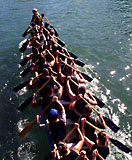 Having spent most of the morning on board
the Kaharoa, I decided to accompany the Discovery Channel
film crew over to the NIWA lab this afternoon where they were going to film
Steve O'Shea as he dissected the most recent giant squid specimen- the
one that we hauled through the streets of Wellington in the
boot (trunk) of Steve's car last week. Although it had only been a few days
since I had last been immersed in squid guts, I figured that a chance
like this doesn't come along all that often so I had better seize the
opportunity when it presented itself. However, as we drove along
the Wellington waterfront, we noticed a large crowd of people gathered
near Queen's wharf all shouting at the top of their lungs. We soon
realized that today was the last round of the Wellington dragonboat races and
that it might be the perfect event to try catching on film.
Having spent most of the morning on board
the Kaharoa, I decided to accompany the Discovery Channel
film crew over to the NIWA lab this afternoon where they were going to film
Steve O'Shea as he dissected the most recent giant squid specimen- the
one that we hauled through the streets of Wellington in the
boot (trunk) of Steve's car last week. Although it had only been a few days
since I had last been immersed in squid guts, I figured that a chance
like this doesn't come along all that often so I had better seize the
opportunity when it presented itself. However, as we drove along
the Wellington waterfront, we noticed a large crowd of people gathered
near Queen's wharf all shouting at the top of their lungs. We soon
realized that today was the last round of the Wellington dragonboat races and
that it might be the perfect event to try catching on film.
 For anybody who has not seen a dragonboat, which is probably quite a few of you, I
believe that they originated in Hong Kong and are very long, very fast
and very narrow boats that have twenty very strong paddlers sitting side by side.
In the bow is a drummer beating out the rhythm for the paddlers to follow and
standing in the stern is the helmsperson with a long sweep oar doing their
best to keep the boat heading in the direction they want to travel.
For anybody who has not seen a dragonboat, which is probably quite a few of you, I
believe that they originated in Hong Kong and are very long, very fast
and very narrow boats that have twenty very strong paddlers sitting side by side.
In the bow is a drummer beating out the rhythm for the paddlers to follow and
standing in the stern is the helmsperson with a long sweep oar doing their
best to keep the boat heading in the direction they want to travel.
 Making our way through the crowds we managed to find a spot which
was relatively free of people and which provided an unobstructed
view of the races. Thinking back on it now, I am not at all surprised
by this because the spot they chose to set up their very expensive
camera was not high and safe on the seawall with the rest of the
spectators, but right down there on the water, perched precariously on
a pile of rocks with salt spray blowing in every direction. In addition
to carrying one of their gear bags, I made myself useful by serving as
a wind and salt spray barricade, jumping out of the way each time
Peter panned the camera in my direction.
Making our way through the crowds we managed to find a spot which
was relatively free of people and which provided an unobstructed
view of the races. Thinking back on it now, I am not at all surprised
by this because the spot they chose to set up their very expensive
camera was not high and safe on the seawall with the rest of the
spectators, but right down there on the water, perched precariously on
a pile of rocks with salt spray blowing in every direction. In addition
to carrying one of their gear bags, I made myself useful by serving as
a wind and salt spray barricade, jumping out of the way each time
Peter panned the camera in my direction.

 Since we had arrived just in time for the final races, the excitement
level was at a fever pitch and tensions were running high.
Every team had their own special uniforms, most brightly
colored and some featuring flowing pennants that danced in the
breeze. Actually breeze is not the correct term. Gale force
winds might have been a more appropriate way to describe the conditions under
which these races were held. Trying to maneuver six very long boats
into a straight line so that none of them crossed the starting line too soon and
to make sure that they were in position in the middle of their racing lane
was no easy thing to do.
Since we had arrived just in time for the final races, the excitement
level was at a fever pitch and tensions were running high.
Every team had their own special uniforms, most brightly
colored and some featuring flowing pennants that danced in the
breeze. Actually breeze is not the correct term. Gale force
winds might have been a more appropriate way to describe the conditions under
which these races were held. Trying to maneuver six very long boats
into a straight line so that none of them crossed the starting line too soon and
to make sure that they were in position in the middle of their racing lane
was no easy thing to do.
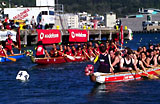 A number of boats actually capsized and more than
one sunk before it made its way to the starting line. Once all the boats were
in position, the race began. Never have I seen so much energy erupt in
such a small amount of time - with perhaps the possible exception of a space shuttle
launch. The boats literally burst out of their starting positions and
moved with remarkable speed down the course. All along the way each team's
fans would be cheering, drums would be pounding and the race announcer would
be calling the play-by-play over the public address system. It was quite
an experience and one that I am very glad to have had the opportunity to
witness first-hand.
A number of boats actually capsized and more than
one sunk before it made its way to the starting line. Once all the boats were
in position, the race began. Never have I seen so much energy erupt in
such a small amount of time - with perhaps the possible exception of a space shuttle
launch. The boats literally burst out of their starting positions and
moved with remarkable speed down the course. All along the way each team's
fans would be cheering, drums would be pounding and the race announcer would
be calling the play-by-play over the public address system. It was quite
an experience and one that I am very glad to have had the opportunity to
witness first-hand.
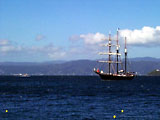 As we were packing up the camera gear before finally heading off to the NIWA lab and the rapidly
defrosting squid that Steve had waiting for us, I spotted something that seemed to have
come from another time. It was large, black-hulled sailing ship steaming into the harbor, silhouetted by the
hills of Wellington. I later learned that the ship was a local sail training vessel named the Spirit of New Zealand.
I found this quite a coincidence since just this past December I spent two weeks aboard the
fully rigged sailing vessel H.M.S. Rose
on a trip from Miami to New York.
As we were packing up the camera gear before finally heading off to the NIWA lab and the rapidly
defrosting squid that Steve had waiting for us, I spotted something that seemed to have
come from another time. It was large, black-hulled sailing ship steaming into the harbor, silhouetted by the
hills of Wellington. I later learned that the ship was a local sail training vessel named the Spirit of New Zealand.
I found this quite a coincidence since just this past December I spent two weeks aboard the
fully rigged sailing vessel H.M.S. Rose
on a trip from Miami to New York.
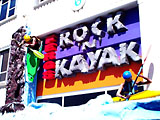
 Walking back to the
film crew I took a minute to stop by a large, barn-like building called Rock 'n' Kayak.
From what I could tell, they seemed to have just about every kayak ever made and there,
at the end of the building, was a floor to ceiling artificial rock climbing cliff. Dangling
from the cliff were kids of all ages, safety lines firmly attached to them at one end and
to their parents on the ground at the other. All I can say is that there was no doubt in
my mind that at least one of the people attached to each rope was having a terrific time.
Walking back to the
film crew I took a minute to stop by a large, barn-like building called Rock 'n' Kayak.
From what I could tell, they seemed to have just about every kayak ever made and there,
at the end of the building, was a floor to ceiling artificial rock climbing cliff. Dangling
from the cliff were kids of all ages, safety lines firmly attached to them at one end and
to their parents on the ground at the other. All I can say is that there was no doubt in
my mind that at least one of the people attached to each rope was having a terrific time.
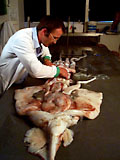
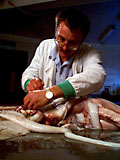 When we finally arrived at the NIWA lab at about 5:30 in the afternoon, Steve
had the giant squid arranged on one of the large dissecting tables. This squid
Steve told us, was a small (1 meter mantle length, approximately 30 kilograms in weight)
but fully mature male that was filled with spermatophores.
Without getting into too many details,
most of which I don't really understand, and others of which I am at a loss to figure out
how to describe in language appropriate for this webpage, I did learn that spermatophores
are the long white, rod-shaped structures
with spring-like coils at one end for mobility
that the males transfer to the females during mating. The spermatophores burrow into the
female and find their way to the eggs which they can then fertilize. Based on the condition of
this particular squid, some of us figured that he must have
been interrupted by the trawl
net at a very inappropriate moment. I was not in the room during Steve's interview so
I cannot describe in detail all the things that he discussed. As they say, I guess you will
just have to tune in and watch the show if you are really interested in finding out.
I for one plan on doing just that.
When we finally arrived at the NIWA lab at about 5:30 in the afternoon, Steve
had the giant squid arranged on one of the large dissecting tables. This squid
Steve told us, was a small (1 meter mantle length, approximately 30 kilograms in weight)
but fully mature male that was filled with spermatophores.
Without getting into too many details,
most of which I don't really understand, and others of which I am at a loss to figure out
how to describe in language appropriate for this webpage, I did learn that spermatophores
are the long white, rod-shaped structures
with spring-like coils at one end for mobility
that the males transfer to the females during mating. The spermatophores burrow into the
female and find their way to the eggs which they can then fertilize. Based on the condition of
this particular squid, some of us figured that he must have
been interrupted by the trawl
net at a very inappropriate moment. I was not in the room during Steve's interview so
I cannot describe in detail all the things that he discussed. As they say, I guess you will
just have to tune in and watch the show if you are really interested in finding out.
I for one plan on doing just that.

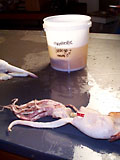 To demonstrate that it is not just Architeuthis that are found in a condition like this,
Steve brought out a pail that contained a relatively small species of squid named
Moroteuthis. The writing on the pail said "Moroteuthis, oversized mature male". I am not sure
as to the scientific protocol used for describing specimens, but in this case we all agreed that it was certainly quite accurate.
To demonstrate that it is not just Architeuthis that are found in a condition like this,
Steve brought out a pail that contained a relatively small species of squid named
Moroteuthis. The writing on the pail said "Moroteuthis, oversized mature male". I am not sure
as to the scientific protocol used for describing specimens, but in this case we all agreed that it was certainly quite accurate.
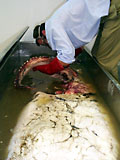 After the interview was over and the film crew had packed up their gear and
headed off to the hotel, Steve and I stayed behind to finish cleaning up the lab and to work
on getting the squid preserved. Yet again I found myself up to my elbows in
squid as we carefully slid the squid into a large blue plastic tub and placed
it once again in the boot of Steve's car. We used the squid to
hold open
the door to his lab while he went in search of the breathing masks that we needed
to wear before we could go into the formalin-filled room where we had placed the
other squid last week. After donning our masks we entered the room and removed
the lid of the coffin-like tank. Through my mask, Steve could hear me gasp as I
saw once again the squid that we had measured before. I had forgotten how large it
was, literally filling the entire tank. Steve carefully placed the squid that we had
just brought in alongside the squid already in the tank and the new one, including arms,
was barely as large as the other one's mantle. Thinking again about the largest known
recorded squid being almost sixty feet long, I began to think that perhaps it
wasn't such a bad idea that I was not going to be able to get to dive to the
depths of Kaikoura Canyon in the Deep Rover after all.
After the interview was over and the film crew had packed up their gear and
headed off to the hotel, Steve and I stayed behind to finish cleaning up the lab and to work
on getting the squid preserved. Yet again I found myself up to my elbows in
squid as we carefully slid the squid into a large blue plastic tub and placed
it once again in the boot of Steve's car. We used the squid to
hold open
the door to his lab while he went in search of the breathing masks that we needed
to wear before we could go into the formalin-filled room where we had placed the
other squid last week. After donning our masks we entered the room and removed
the lid of the coffin-like tank. Through my mask, Steve could hear me gasp as I
saw once again the squid that we had measured before. I had forgotten how large it
was, literally filling the entire tank. Steve carefully placed the squid that we had
just brought in alongside the squid already in the tank and the new one, including arms,
was barely as large as the other one's mantle. Thinking again about the largest known
recorded squid being almost sixty feet long, I began to think that perhaps it
wasn't such a bad idea that I was not going to be able to get to dive to the
depths of Kaikoura Canyon in the Deep Rover after all.
best regards,
gene
 For anybody who has not seen a dragonboat, which is probably quite a few of you, I
believe that they originated in Hong Kong and are very long, very fast
and very narrow boats that have twenty very strong paddlers sitting side by side.
In the bow is a drummer beating out the rhythm for the paddlers to follow and
standing in the stern is the helmsperson with a long sweep oar doing their
best to keep the boat heading in the direction they want to travel.
For anybody who has not seen a dragonboat, which is probably quite a few of you, I
believe that they originated in Hong Kong and are very long, very fast
and very narrow boats that have twenty very strong paddlers sitting side by side.
In the bow is a drummer beating out the rhythm for the paddlers to follow and
standing in the stern is the helmsperson with a long sweep oar doing their
best to keep the boat heading in the direction they want to travel.
 Having spent most of the morning on board
the Kaharoa, I decided to accompany the Discovery Channel
film crew over to the NIWA lab this afternoon where they were going to film
Steve O'Shea as he dissected the most recent giant squid specimen- the
one that we hauled through the streets of Wellington in the
boot (trunk) of Steve's car last week. Although it had only been a few days
since I had last been immersed in squid guts, I figured that a chance
like this doesn't come along all that often so I had better seize the
opportunity when it presented itself. However, as we drove along
the Wellington waterfront, we noticed a large crowd of people gathered
near Queen's wharf all shouting at the top of their lungs. We soon
realized that today was the last round of the Wellington dragonboat races and
that it might be the perfect event to try catching on film.
Having spent most of the morning on board
the Kaharoa, I decided to accompany the Discovery Channel
film crew over to the NIWA lab this afternoon where they were going to film
Steve O'Shea as he dissected the most recent giant squid specimen- the
one that we hauled through the streets of Wellington in the
boot (trunk) of Steve's car last week. Although it had only been a few days
since I had last been immersed in squid guts, I figured that a chance
like this doesn't come along all that often so I had better seize the
opportunity when it presented itself. However, as we drove along
the Wellington waterfront, we noticed a large crowd of people gathered
near Queen's wharf all shouting at the top of their lungs. We soon
realized that today was the last round of the Wellington dragonboat races and
that it might be the perfect event to try catching on film.











